HRMT 151 - Labour Relations: Evaluating Bargaining Power in Scenarios
VerifiedAdded on 2023/06/03
|10
|2491
|476
Case Study
AI Summary
This case study analyzes the bargaining power dynamics in three distinct companies: Grocery-Right, PowerCo, and Chemical Corp. Grocery-Right, a grocery chain, faces strong union bargaining power due to potential strike impacts on customer flow and sales. PowerCo, a manufacturing company with multiple plants and unions, holds greater bargaining power through horizontal integration and decentralized union negotiations. Chemical Corp, a chemical company, possesses a slight bargaining edge due to its multinational status and unionization avoidance strategies, though potential strike costs and wage disparity issues pose challenges. The analysis considers internal and external factors influencing each company's bargaining position, including market competition, union structure, and operational resilience. The document concludes that a consolidated union strategy could shift the bargaining power dynamics in favor of the workers in certain scenarios. Desklib provides a platform for students to access similar solved assignments and past papers.
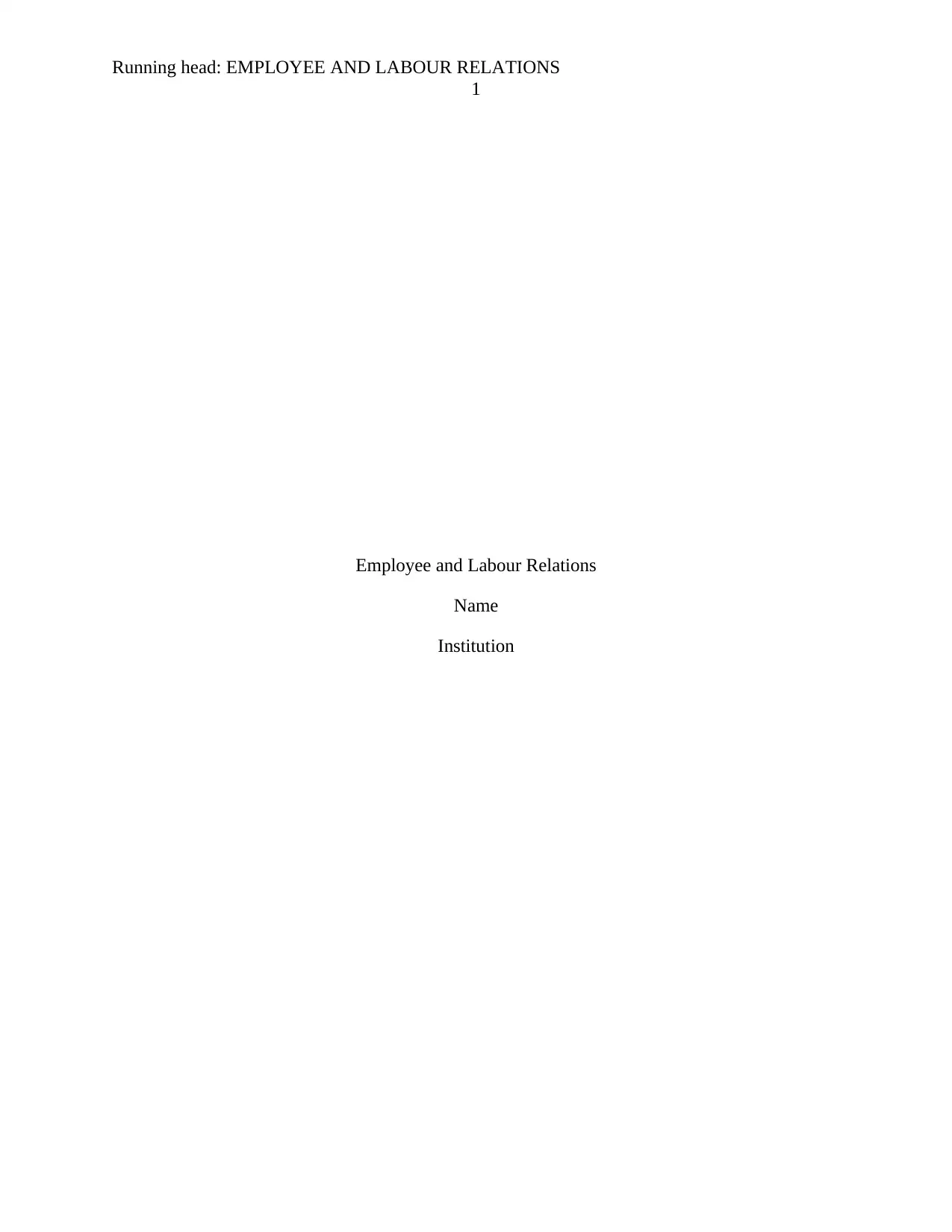
Running head: EMPLOYEE AND LABOUR RELATIONS
1
Employee and Labour Relations
Name
Institution
1
Employee and Labour Relations
Name
Institution
Paraphrase This Document
Need a fresh take? Get an instant paraphrase of this document with our AI Paraphraser
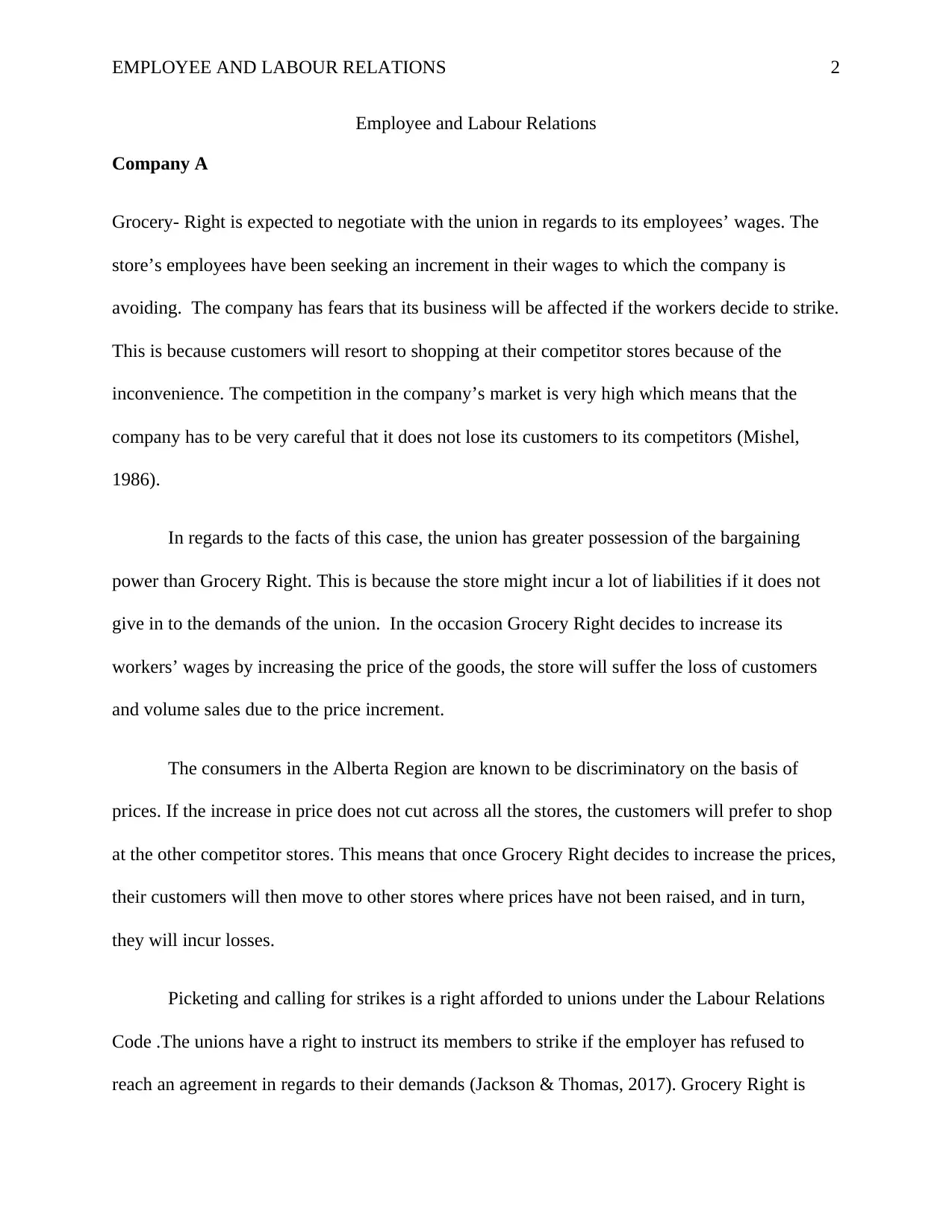
EMPLOYEE AND LABOUR RELATIONS 2
Employee and Labour Relations
Company A
Grocery- Right is expected to negotiate with the union in regards to its employees’ wages. The
store’s employees have been seeking an increment in their wages to which the company is
avoiding. The company has fears that its business will be affected if the workers decide to strike.
This is because customers will resort to shopping at their competitor stores because of the
inconvenience. The competition in the company’s market is very high which means that the
company has to be very careful that it does not lose its customers to its competitors (Mishel,
1986).
In regards to the facts of this case, the union has greater possession of the bargaining
power than Grocery Right. This is because the store might incur a lot of liabilities if it does not
give in to the demands of the union. In the occasion Grocery Right decides to increase its
workers’ wages by increasing the price of the goods, the store will suffer the loss of customers
and volume sales due to the price increment.
The consumers in the Alberta Region are known to be discriminatory on the basis of
prices. If the increase in price does not cut across all the stores, the customers will prefer to shop
at the other competitor stores. This means that once Grocery Right decides to increase the prices,
their customers will then move to other stores where prices have not been raised, and in turn,
they will incur losses.
Picketing and calling for strikes is a right afforded to unions under the Labour Relations
Code .The unions have a right to instruct its members to strike if the employer has refused to
reach an agreement in regards to their demands (Jackson & Thomas, 2017). Grocery Right is
Employee and Labour Relations
Company A
Grocery- Right is expected to negotiate with the union in regards to its employees’ wages. The
store’s employees have been seeking an increment in their wages to which the company is
avoiding. The company has fears that its business will be affected if the workers decide to strike.
This is because customers will resort to shopping at their competitor stores because of the
inconvenience. The competition in the company’s market is very high which means that the
company has to be very careful that it does not lose its customers to its competitors (Mishel,
1986).
In regards to the facts of this case, the union has greater possession of the bargaining
power than Grocery Right. This is because the store might incur a lot of liabilities if it does not
give in to the demands of the union. In the occasion Grocery Right decides to increase its
workers’ wages by increasing the price of the goods, the store will suffer the loss of customers
and volume sales due to the price increment.
The consumers in the Alberta Region are known to be discriminatory on the basis of
prices. If the increase in price does not cut across all the stores, the customers will prefer to shop
at the other competitor stores. This means that once Grocery Right decides to increase the prices,
their customers will then move to other stores where prices have not been raised, and in turn,
they will incur losses.
Picketing and calling for strikes is a right afforded to unions under the Labour Relations
Code .The unions have a right to instruct its members to strike if the employer has refused to
reach an agreement in regards to their demands (Jackson & Thomas, 2017). Grocery Right is
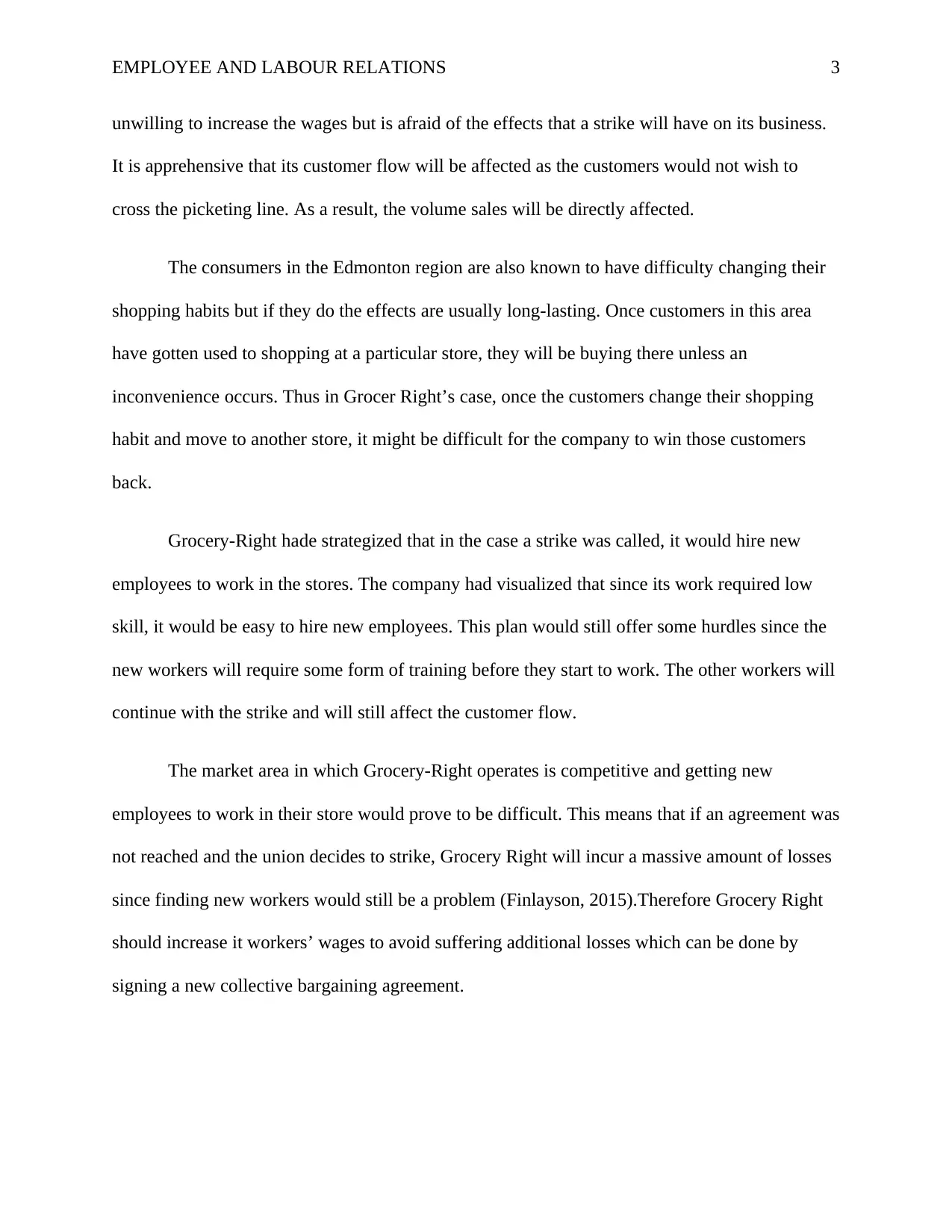
EMPLOYEE AND LABOUR RELATIONS 3
unwilling to increase the wages but is afraid of the effects that a strike will have on its business.
It is apprehensive that its customer flow will be affected as the customers would not wish to
cross the picketing line. As a result, the volume sales will be directly affected.
The consumers in the Edmonton region are also known to have difficulty changing their
shopping habits but if they do the effects are usually long-lasting. Once customers in this area
have gotten used to shopping at a particular store, they will be buying there unless an
inconvenience occurs. Thus in Grocer Right’s case, once the customers change their shopping
habit and move to another store, it might be difficult for the company to win those customers
back.
Grocery-Right hade strategized that in the case a strike was called, it would hire new
employees to work in the stores. The company had visualized that since its work required low
skill, it would be easy to hire new employees. This plan would still offer some hurdles since the
new workers will require some form of training before they start to work. The other workers will
continue with the strike and will still affect the customer flow.
The market area in which Grocery-Right operates is competitive and getting new
employees to work in their store would prove to be difficult. This means that if an agreement was
not reached and the union decides to strike, Grocery Right will incur a massive amount of losses
since finding new workers would still be a problem (Finlayson, 2015).Therefore Grocery Right
should increase it workers’ wages to avoid suffering additional losses which can be done by
signing a new collective bargaining agreement.
unwilling to increase the wages but is afraid of the effects that a strike will have on its business.
It is apprehensive that its customer flow will be affected as the customers would not wish to
cross the picketing line. As a result, the volume sales will be directly affected.
The consumers in the Edmonton region are also known to have difficulty changing their
shopping habits but if they do the effects are usually long-lasting. Once customers in this area
have gotten used to shopping at a particular store, they will be buying there unless an
inconvenience occurs. Thus in Grocer Right’s case, once the customers change their shopping
habit and move to another store, it might be difficult for the company to win those customers
back.
Grocery-Right hade strategized that in the case a strike was called, it would hire new
employees to work in the stores. The company had visualized that since its work required low
skill, it would be easy to hire new employees. This plan would still offer some hurdles since the
new workers will require some form of training before they start to work. The other workers will
continue with the strike and will still affect the customer flow.
The market area in which Grocery-Right operates is competitive and getting new
employees to work in their store would prove to be difficult. This means that if an agreement was
not reached and the union decides to strike, Grocery Right will incur a massive amount of losses
since finding new workers would still be a problem (Finlayson, 2015).Therefore Grocery Right
should increase it workers’ wages to avoid suffering additional losses which can be done by
signing a new collective bargaining agreement.
⊘ This is a preview!⊘
Do you want full access?
Subscribe today to unlock all pages.

Trusted by 1+ million students worldwide
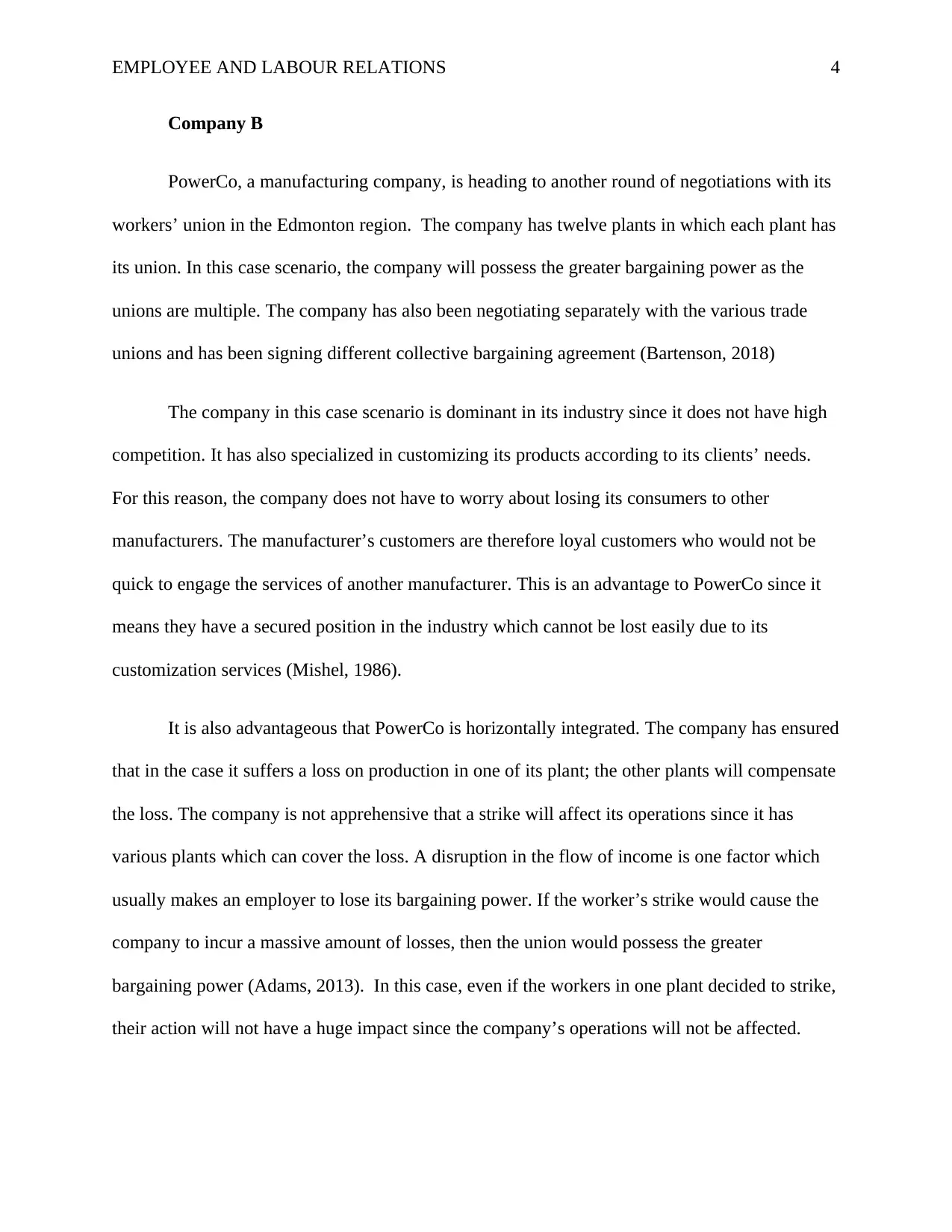
EMPLOYEE AND LABOUR RELATIONS 4
Company B
PowerCo, a manufacturing company, is heading to another round of negotiations with its
workers’ union in the Edmonton region. The company has twelve plants in which each plant has
its union. In this case scenario, the company will possess the greater bargaining power as the
unions are multiple. The company has also been negotiating separately with the various trade
unions and has been signing different collective bargaining agreement (Bartenson, 2018)
The company in this case scenario is dominant in its industry since it does not have high
competition. It has also specialized in customizing its products according to its clients’ needs.
For this reason, the company does not have to worry about losing its consumers to other
manufacturers. The manufacturer’s customers are therefore loyal customers who would not be
quick to engage the services of another manufacturer. This is an advantage to PowerCo since it
means they have a secured position in the industry which cannot be lost easily due to its
customization services (Mishel, 1986).
It is also advantageous that PowerCo is horizontally integrated. The company has ensured
that in the case it suffers a loss on production in one of its plant; the other plants will compensate
the loss. The company is not apprehensive that a strike will affect its operations since it has
various plants which can cover the loss. A disruption in the flow of income is one factor which
usually makes an employer to lose its bargaining power. If the worker’s strike would cause the
company to incur a massive amount of losses, then the union would possess the greater
bargaining power (Adams, 2013). In this case, even if the workers in one plant decided to strike,
their action will not have a huge impact since the company’s operations will not be affected.
Company B
PowerCo, a manufacturing company, is heading to another round of negotiations with its
workers’ union in the Edmonton region. The company has twelve plants in which each plant has
its union. In this case scenario, the company will possess the greater bargaining power as the
unions are multiple. The company has also been negotiating separately with the various trade
unions and has been signing different collective bargaining agreement (Bartenson, 2018)
The company in this case scenario is dominant in its industry since it does not have high
competition. It has also specialized in customizing its products according to its clients’ needs.
For this reason, the company does not have to worry about losing its consumers to other
manufacturers. The manufacturer’s customers are therefore loyal customers who would not be
quick to engage the services of another manufacturer. This is an advantage to PowerCo since it
means they have a secured position in the industry which cannot be lost easily due to its
customization services (Mishel, 1986).
It is also advantageous that PowerCo is horizontally integrated. The company has ensured
that in the case it suffers a loss on production in one of its plant; the other plants will compensate
the loss. The company is not apprehensive that a strike will affect its operations since it has
various plants which can cover the loss. A disruption in the flow of income is one factor which
usually makes an employer to lose its bargaining power. If the worker’s strike would cause the
company to incur a massive amount of losses, then the union would possess the greater
bargaining power (Adams, 2013). In this case, even if the workers in one plant decided to strike,
their action will not have a huge impact since the company’s operations will not be affected.
Paraphrase This Document
Need a fresh take? Get an instant paraphrase of this document with our AI Paraphraser
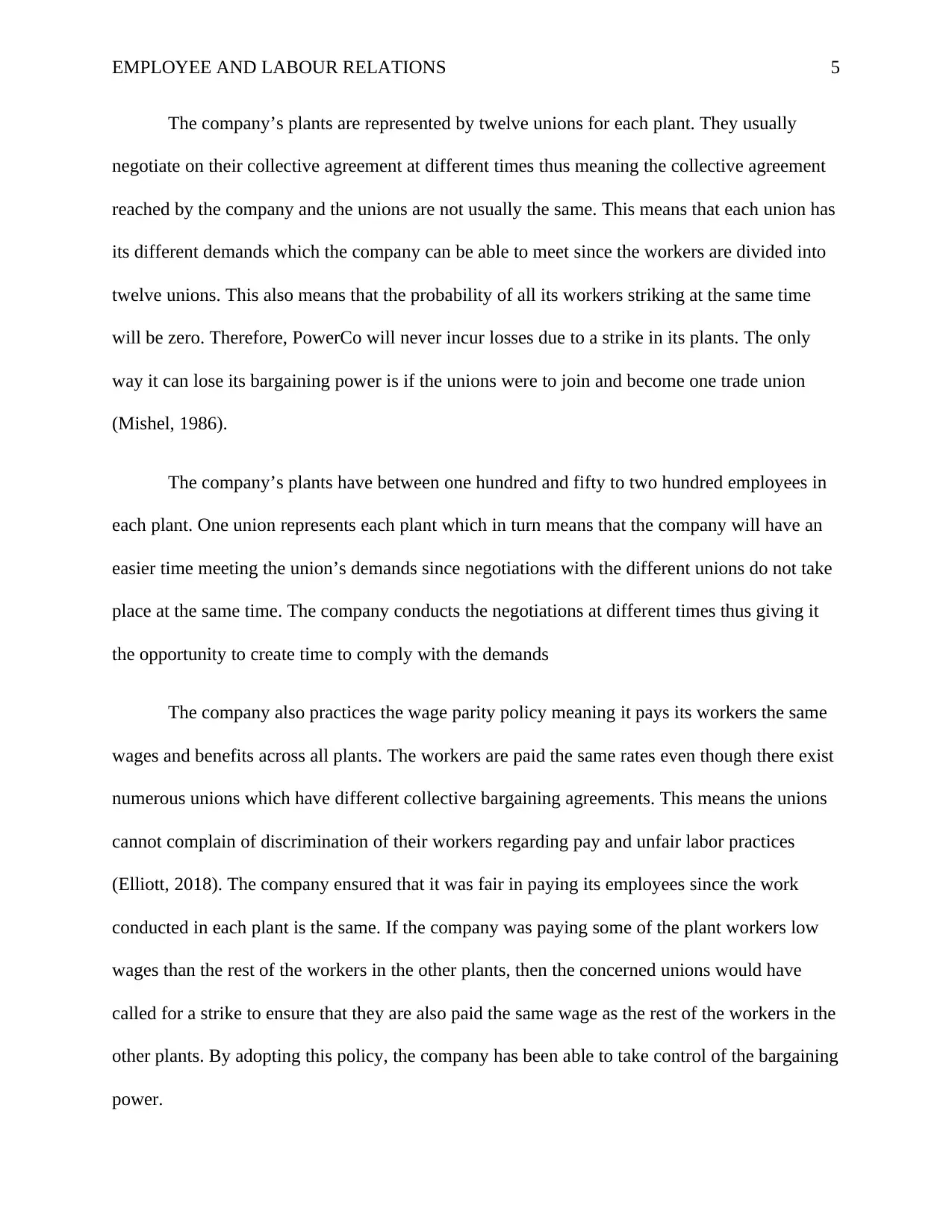
EMPLOYEE AND LABOUR RELATIONS 5
The company’s plants are represented by twelve unions for each plant. They usually
negotiate on their collective agreement at different times thus meaning the collective agreement
reached by the company and the unions are not usually the same. This means that each union has
its different demands which the company can be able to meet since the workers are divided into
twelve unions. This also means that the probability of all its workers striking at the same time
will be zero. Therefore, PowerCo will never incur losses due to a strike in its plants. The only
way it can lose its bargaining power is if the unions were to join and become one trade union
(Mishel, 1986).
The company’s plants have between one hundred and fifty to two hundred employees in
each plant. One union represents each plant which in turn means that the company will have an
easier time meeting the union’s demands since negotiations with the different unions do not take
place at the same time. The company conducts the negotiations at different times thus giving it
the opportunity to create time to comply with the demands
The company also practices the wage parity policy meaning it pays its workers the same
wages and benefits across all plants. The workers are paid the same rates even though there exist
numerous unions which have different collective bargaining agreements. This means the unions
cannot complain of discrimination of their workers regarding pay and unfair labor practices
(Elliott, 2018). The company ensured that it was fair in paying its employees since the work
conducted in each plant is the same. If the company was paying some of the plant workers low
wages than the rest of the workers in the other plants, then the concerned unions would have
called for a strike to ensure that they are also paid the same wage as the rest of the workers in the
other plants. By adopting this policy, the company has been able to take control of the bargaining
power.
The company’s plants are represented by twelve unions for each plant. They usually
negotiate on their collective agreement at different times thus meaning the collective agreement
reached by the company and the unions are not usually the same. This means that each union has
its different demands which the company can be able to meet since the workers are divided into
twelve unions. This also means that the probability of all its workers striking at the same time
will be zero. Therefore, PowerCo will never incur losses due to a strike in its plants. The only
way it can lose its bargaining power is if the unions were to join and become one trade union
(Mishel, 1986).
The company’s plants have between one hundred and fifty to two hundred employees in
each plant. One union represents each plant which in turn means that the company will have an
easier time meeting the union’s demands since negotiations with the different unions do not take
place at the same time. The company conducts the negotiations at different times thus giving it
the opportunity to create time to comply with the demands
The company also practices the wage parity policy meaning it pays its workers the same
wages and benefits across all plants. The workers are paid the same rates even though there exist
numerous unions which have different collective bargaining agreements. This means the unions
cannot complain of discrimination of their workers regarding pay and unfair labor practices
(Elliott, 2018). The company ensured that it was fair in paying its employees since the work
conducted in each plant is the same. If the company was paying some of the plant workers low
wages than the rest of the workers in the other plants, then the concerned unions would have
called for a strike to ensure that they are also paid the same wage as the rest of the workers in the
other plants. By adopting this policy, the company has been able to take control of the bargaining
power.
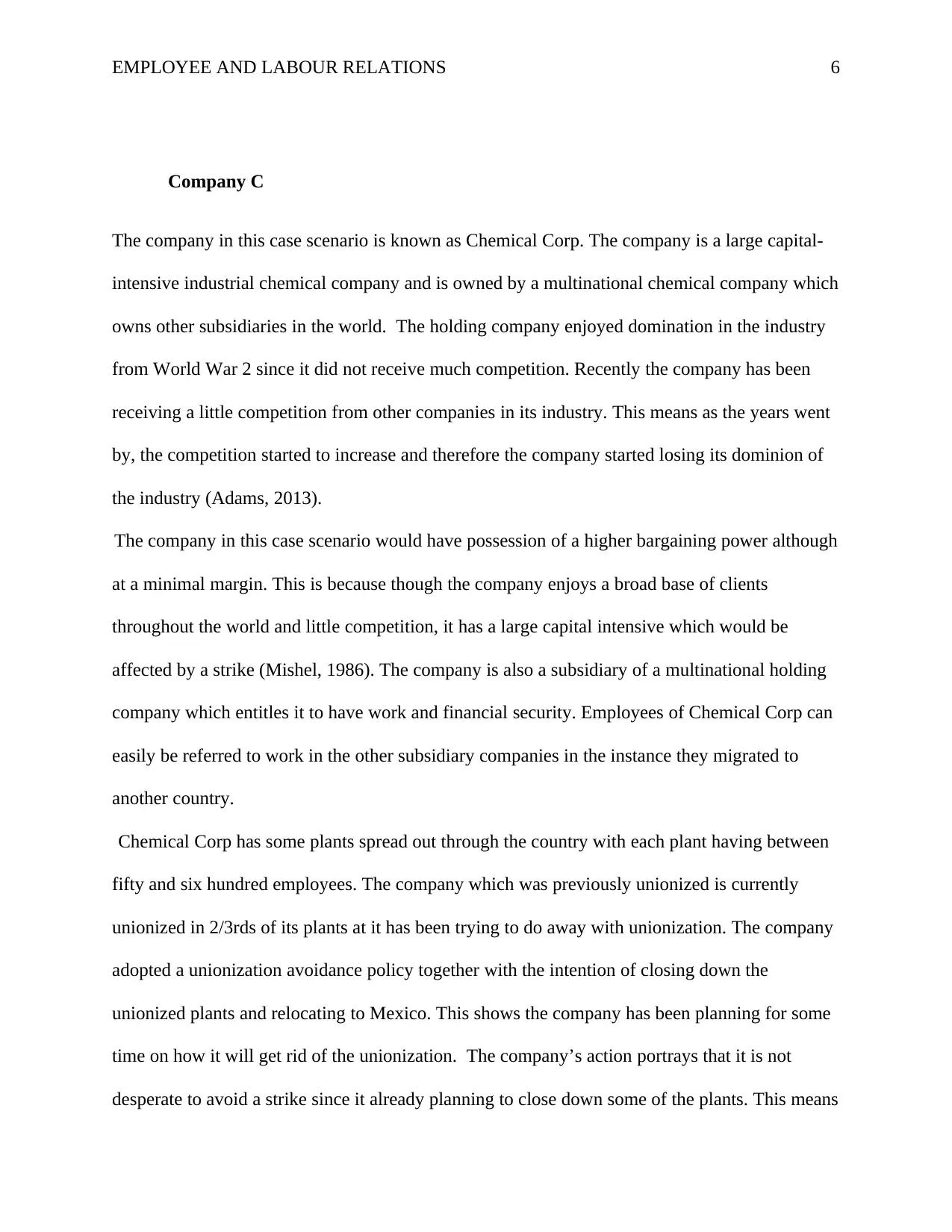
EMPLOYEE AND LABOUR RELATIONS 6
Company C
The company in this case scenario is known as Chemical Corp. The company is a large capital-
intensive industrial chemical company and is owned by a multinational chemical company which
owns other subsidiaries in the world. The holding company enjoyed domination in the industry
from World War 2 since it did not receive much competition. Recently the company has been
receiving a little competition from other companies in its industry. This means as the years went
by, the competition started to increase and therefore the company started losing its dominion of
the industry (Adams, 2013).
The company in this case scenario would have possession of a higher bargaining power although
at a minimal margin. This is because though the company enjoys a broad base of clients
throughout the world and little competition, it has a large capital intensive which would be
affected by a strike (Mishel, 1986). The company is also a subsidiary of a multinational holding
company which entitles it to have work and financial security. Employees of Chemical Corp can
easily be referred to work in the other subsidiary companies in the instance they migrated to
another country.
Chemical Corp has some plants spread out through the country with each plant having between
fifty and six hundred employees. The company which was previously unionized is currently
unionized in 2/3rds of its plants at it has been trying to do away with unionization. The company
adopted a unionization avoidance policy together with the intention of closing down the
unionized plants and relocating to Mexico. This shows the company has been planning for some
time on how it will get rid of the unionization. The company’s action portrays that it is not
desperate to avoid a strike since it already planning to close down some of the plants. This means
Company C
The company in this case scenario is known as Chemical Corp. The company is a large capital-
intensive industrial chemical company and is owned by a multinational chemical company which
owns other subsidiaries in the world. The holding company enjoyed domination in the industry
from World War 2 since it did not receive much competition. Recently the company has been
receiving a little competition from other companies in its industry. This means as the years went
by, the competition started to increase and therefore the company started losing its dominion of
the industry (Adams, 2013).
The company in this case scenario would have possession of a higher bargaining power although
at a minimal margin. This is because though the company enjoys a broad base of clients
throughout the world and little competition, it has a large capital intensive which would be
affected by a strike (Mishel, 1986). The company is also a subsidiary of a multinational holding
company which entitles it to have work and financial security. Employees of Chemical Corp can
easily be referred to work in the other subsidiary companies in the instance they migrated to
another country.
Chemical Corp has some plants spread out through the country with each plant having between
fifty and six hundred employees. The company which was previously unionized is currently
unionized in 2/3rds of its plants at it has been trying to do away with unionization. The company
adopted a unionization avoidance policy together with the intention of closing down the
unionized plants and relocating to Mexico. This shows the company has been planning for some
time on how it will get rid of the unionization. The company’s action portrays that it is not
desperate to avoid a strike since it already planning to close down some of the plants. This means
⊘ This is a preview!⊘
Do you want full access?
Subscribe today to unlock all pages.

Trusted by 1+ million students worldwide
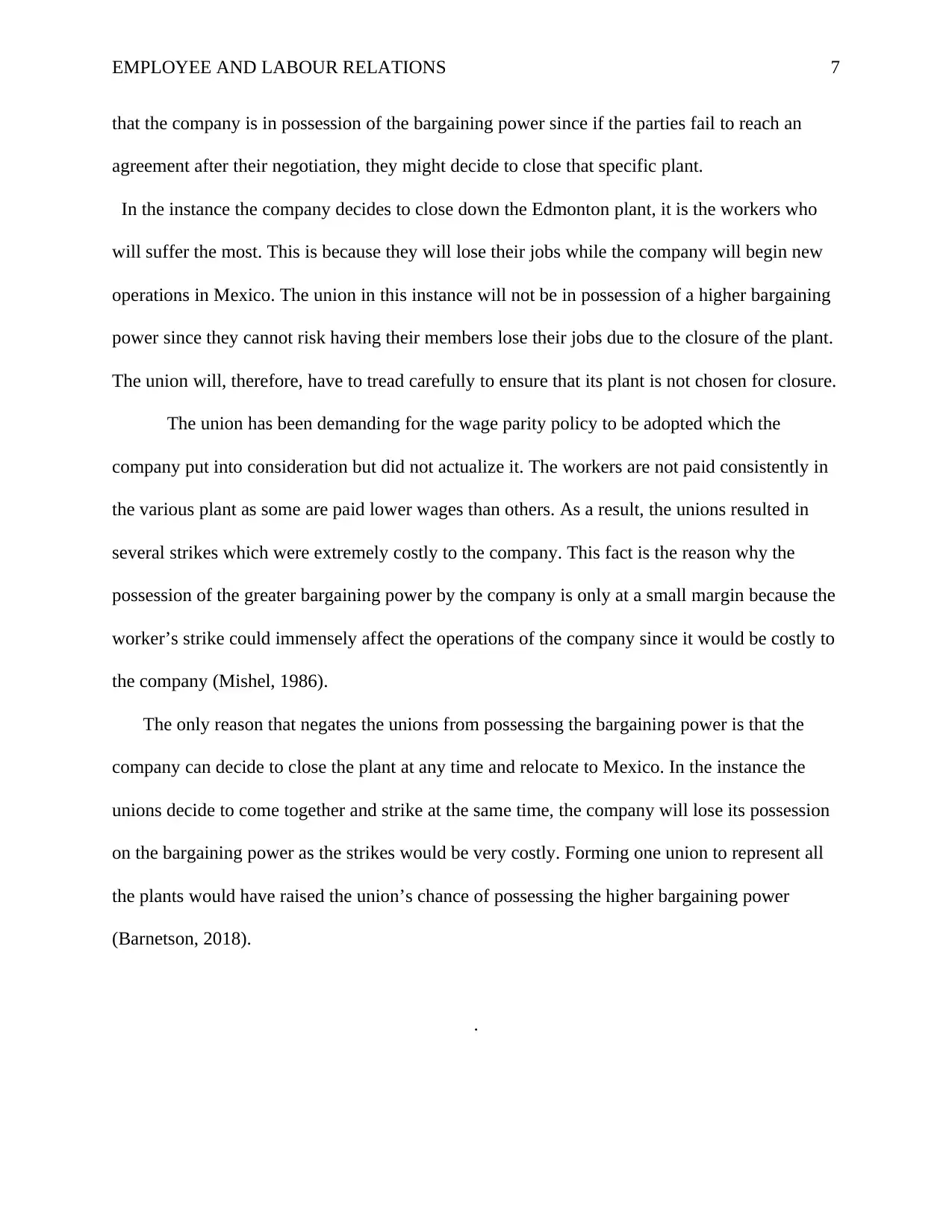
EMPLOYEE AND LABOUR RELATIONS 7
that the company is in possession of the bargaining power since if the parties fail to reach an
agreement after their negotiation, they might decide to close that specific plant.
In the instance the company decides to close down the Edmonton plant, it is the workers who
will suffer the most. This is because they will lose their jobs while the company will begin new
operations in Mexico. The union in this instance will not be in possession of a higher bargaining
power since they cannot risk having their members lose their jobs due to the closure of the plant.
The union will, therefore, have to tread carefully to ensure that its plant is not chosen for closure.
The union has been demanding for the wage parity policy to be adopted which the
company put into consideration but did not actualize it. The workers are not paid consistently in
the various plant as some are paid lower wages than others. As a result, the unions resulted in
several strikes which were extremely costly to the company. This fact is the reason why the
possession of the greater bargaining power by the company is only at a small margin because the
worker’s strike could immensely affect the operations of the company since it would be costly to
the company (Mishel, 1986).
The only reason that negates the unions from possessing the bargaining power is that the
company can decide to close the plant at any time and relocate to Mexico. In the instance the
unions decide to come together and strike at the same time, the company will lose its possession
on the bargaining power as the strikes would be very costly. Forming one union to represent all
the plants would have raised the union’s chance of possessing the higher bargaining power
(Barnetson, 2018).
.
that the company is in possession of the bargaining power since if the parties fail to reach an
agreement after their negotiation, they might decide to close that specific plant.
In the instance the company decides to close down the Edmonton plant, it is the workers who
will suffer the most. This is because they will lose their jobs while the company will begin new
operations in Mexico. The union in this instance will not be in possession of a higher bargaining
power since they cannot risk having their members lose their jobs due to the closure of the plant.
The union will, therefore, have to tread carefully to ensure that its plant is not chosen for closure.
The union has been demanding for the wage parity policy to be adopted which the
company put into consideration but did not actualize it. The workers are not paid consistently in
the various plant as some are paid lower wages than others. As a result, the unions resulted in
several strikes which were extremely costly to the company. This fact is the reason why the
possession of the greater bargaining power by the company is only at a small margin because the
worker’s strike could immensely affect the operations of the company since it would be costly to
the company (Mishel, 1986).
The only reason that negates the unions from possessing the bargaining power is that the
company can decide to close the plant at any time and relocate to Mexico. In the instance the
unions decide to come together and strike at the same time, the company will lose its possession
on the bargaining power as the strikes would be very costly. Forming one union to represent all
the plants would have raised the union’s chance of possessing the higher bargaining power
(Barnetson, 2018).
.
Paraphrase This Document
Need a fresh take? Get an instant paraphrase of this document with our AI Paraphraser
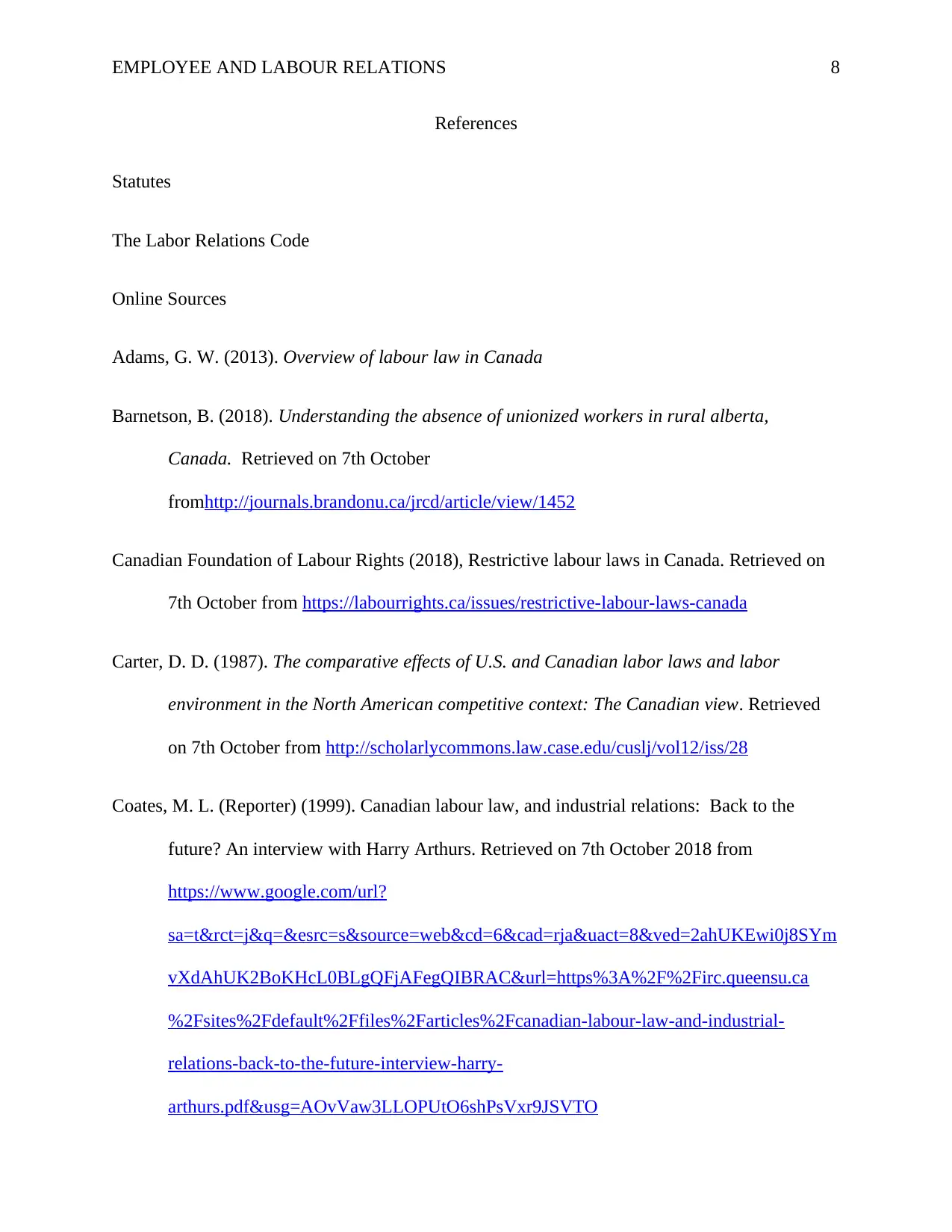
EMPLOYEE AND LABOUR RELATIONS 8
References
Statutes
The Labor Relations Code
Online Sources
Adams, G. W. (2013). Overview of labour law in Canada
Barnetson, B. (2018). Understanding the absence of unionized workers in rural alberta,
Canada. Retrieved on 7th October
fromhttp://journals.brandonu.ca/jrcd/article/view/1452
Canadian Foundation of Labour Rights (2018), Restrictive labour laws in Canada. Retrieved on
7th October from https://labourrights.ca/issues/restrictive-labour-laws-canada
Carter, D. D. (1987). The comparative effects of U.S. and Canadian labor laws and labor
environment in the North American competitive context: The Canadian view. Retrieved
on 7th October from http://scholarlycommons.law.case.edu/cuslj/vol12/iss/28
Coates, M. L. (Reporter) (1999). Canadian labour law, and industrial relations: Back to the
future? An interview with Harry Arthurs. Retrieved on 7th October 2018 from
https://www.google.com/url?
sa=t&rct=j&q=&esrc=s&source=web&cd=6&cad=rja&uact=8&ved=2ahUKEwi0j8SYm
vXdAhUK2BoKHcL0BLgQFjAFegQIBRAC&url=https%3A%2F%2Firc.queensu.ca
%2Fsites%2Fdefault%2Ffiles%2Farticles%2Fcanadian-labour-law-and-industrial-
relations-back-to-the-future-interview-harry-
arthurs.pdf&usg=AOvVaw3LLOPUtO6shPsVxr9JSVTO
References
Statutes
The Labor Relations Code
Online Sources
Adams, G. W. (2013). Overview of labour law in Canada
Barnetson, B. (2018). Understanding the absence of unionized workers in rural alberta,
Canada. Retrieved on 7th October
fromhttp://journals.brandonu.ca/jrcd/article/view/1452
Canadian Foundation of Labour Rights (2018), Restrictive labour laws in Canada. Retrieved on
7th October from https://labourrights.ca/issues/restrictive-labour-laws-canada
Carter, D. D. (1987). The comparative effects of U.S. and Canadian labor laws and labor
environment in the North American competitive context: The Canadian view. Retrieved
on 7th October from http://scholarlycommons.law.case.edu/cuslj/vol12/iss/28
Coates, M. L. (Reporter) (1999). Canadian labour law, and industrial relations: Back to the
future? An interview with Harry Arthurs. Retrieved on 7th October 2018 from
https://www.google.com/url?
sa=t&rct=j&q=&esrc=s&source=web&cd=6&cad=rja&uact=8&ved=2ahUKEwi0j8SYm
vXdAhUK2BoKHcL0BLgQFjAFegQIBRAC&url=https%3A%2F%2Firc.queensu.ca
%2Fsites%2Fdefault%2Ffiles%2Farticles%2Fcanadian-labour-law-and-industrial-
relations-back-to-the-future-interview-harry-
arthurs.pdf&usg=AOvVaw3LLOPUtO6shPsVxr9JSVTO
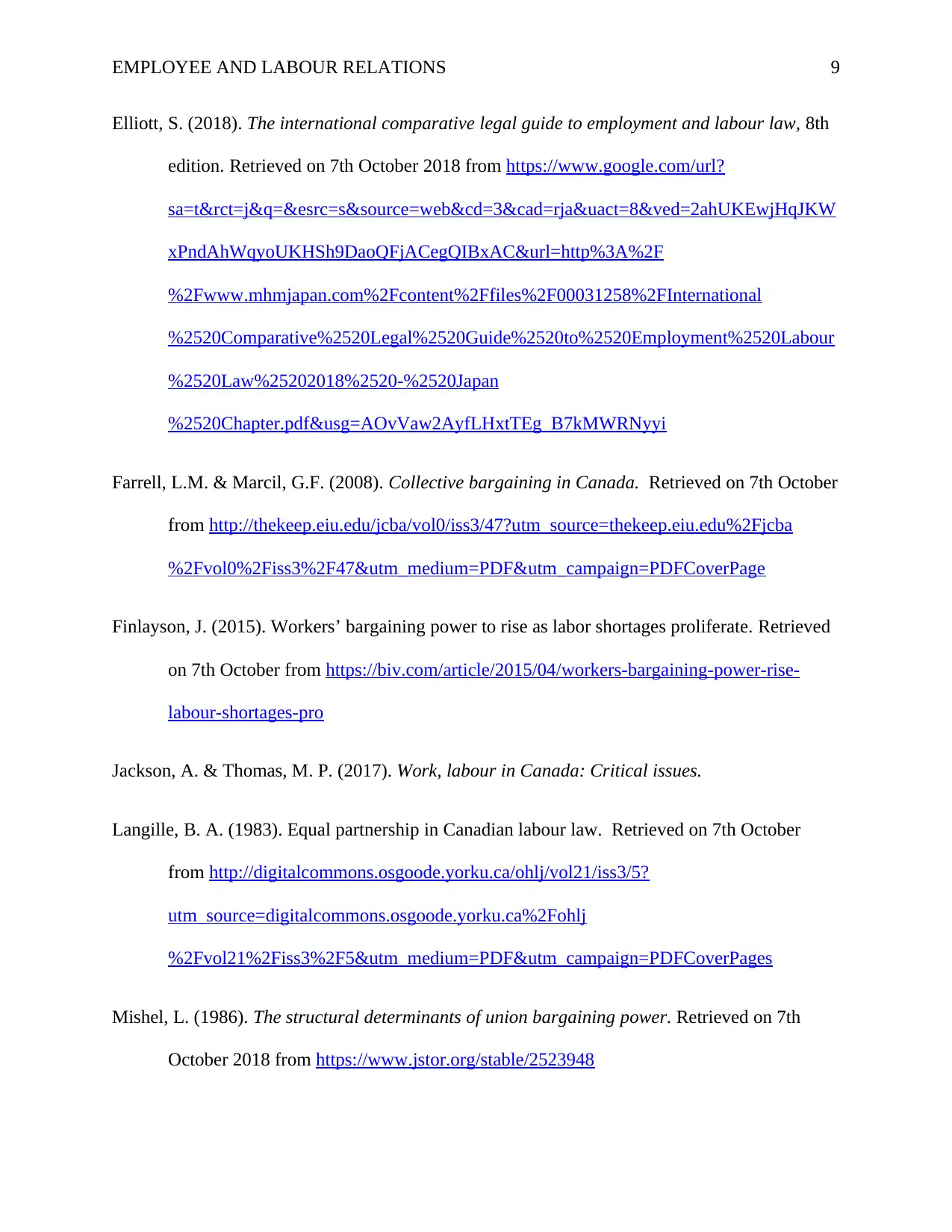
EMPLOYEE AND LABOUR RELATIONS 9
Elliott, S. (2018). The international comparative legal guide to employment and labour law, 8th
edition. Retrieved on 7th October 2018 from https://www.google.com/url?
sa=t&rct=j&q=&esrc=s&source=web&cd=3&cad=rja&uact=8&ved=2ahUKEwjHqJKW
xPndAhWqyoUKHSh9DaoQFjACegQIBxAC&url=http%3A%2F
%2Fwww.mhmjapan.com%2Fcontent%2Ffiles%2F00031258%2FInternational
%2520Comparative%2520Legal%2520Guide%2520to%2520Employment%2520Labour
%2520Law%25202018%2520-%2520Japan
%2520Chapter.pdf&usg=AOvVaw2AyfLHxtTEg_B7kMWRNyyi
Farrell, L.M. & Marcil, G.F. (2008). Collective bargaining in Canada. Retrieved on 7th October
from http://thekeep.eiu.edu/jcba/vol0/iss3/47?utm_source=thekeep.eiu.edu%2Fjcba
%2Fvol0%2Fiss3%2F47&utm_medium=PDF&utm_campaign=PDFCoverPage
Finlayson, J. (2015). Workers’ bargaining power to rise as labor shortages proliferate. Retrieved
on 7th October from https://biv.com/article/2015/04/workers-bargaining-power-rise-
labour-shortages-pro
Jackson, A. & Thomas, M. P. (2017). Work, labour in Canada: Critical issues.
Langille, B. A. (1983). Equal partnership in Canadian labour law. Retrieved on 7th October
from http://digitalcommons.osgoode.yorku.ca/ohlj/vol21/iss3/5?
utm_source=digitalcommons.osgoode.yorku.ca%2Fohlj
%2Fvol21%2Fiss3%2F5&utm_medium=PDF&utm_campaign=PDFCoverPages
Mishel, L. (1986). The structural determinants of union bargaining power. Retrieved on 7th
October 2018 from https://www.jstor.org/stable/2523948
Elliott, S. (2018). The international comparative legal guide to employment and labour law, 8th
edition. Retrieved on 7th October 2018 from https://www.google.com/url?
sa=t&rct=j&q=&esrc=s&source=web&cd=3&cad=rja&uact=8&ved=2ahUKEwjHqJKW
xPndAhWqyoUKHSh9DaoQFjACegQIBxAC&url=http%3A%2F
%2Fwww.mhmjapan.com%2Fcontent%2Ffiles%2F00031258%2FInternational
%2520Comparative%2520Legal%2520Guide%2520to%2520Employment%2520Labour
%2520Law%25202018%2520-%2520Japan
%2520Chapter.pdf&usg=AOvVaw2AyfLHxtTEg_B7kMWRNyyi
Farrell, L.M. & Marcil, G.F. (2008). Collective bargaining in Canada. Retrieved on 7th October
from http://thekeep.eiu.edu/jcba/vol0/iss3/47?utm_source=thekeep.eiu.edu%2Fjcba
%2Fvol0%2Fiss3%2F47&utm_medium=PDF&utm_campaign=PDFCoverPage
Finlayson, J. (2015). Workers’ bargaining power to rise as labor shortages proliferate. Retrieved
on 7th October from https://biv.com/article/2015/04/workers-bargaining-power-rise-
labour-shortages-pro
Jackson, A. & Thomas, M. P. (2017). Work, labour in Canada: Critical issues.
Langille, B. A. (1983). Equal partnership in Canadian labour law. Retrieved on 7th October
from http://digitalcommons.osgoode.yorku.ca/ohlj/vol21/iss3/5?
utm_source=digitalcommons.osgoode.yorku.ca%2Fohlj
%2Fvol21%2Fiss3%2F5&utm_medium=PDF&utm_campaign=PDFCoverPages
Mishel, L. (1986). The structural determinants of union bargaining power. Retrieved on 7th
October 2018 from https://www.jstor.org/stable/2523948
⊘ This is a preview!⊘
Do you want full access?
Subscribe today to unlock all pages.

Trusted by 1+ million students worldwide

EMPLOYEE AND LABOUR RELATIONS 10
1 out of 10
Related Documents
Your All-in-One AI-Powered Toolkit for Academic Success.
+13062052269
info@desklib.com
Available 24*7 on WhatsApp / Email
![[object Object]](/_next/static/media/star-bottom.7253800d.svg)
Unlock your academic potential
Copyright © 2020–2025 A2Z Services. All Rights Reserved. Developed and managed by ZUCOL.



